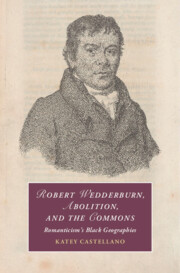Book contents
- Robert Wedderburn, Abolition, and the Commons
- Cambridge Studies in Romanticism
- Robert Wedderburn, Abolition, and the Commons
- Copyright page
- Contents
- Figures
- Acknowledgments
- Introduction
- Chapter 1 Against Private Property
- Chapter 2 From Plantation to Prison
- Chapter 3 Black Women’s Abolitionist Geographies in The Horrors of Slavery and The History of Mary Prince
- Chapter 4 Provisions and Pigs
- Chapter 5 Maroon Settlements as Abolitionist Commons
- Chapter 6 Emancipation as the Enclosure of “Waste Fertility”
- Conclusion
- Notes
- Bibliography
- Index
- Cambridge Studies In Romanticism
- References
Bibliography
Published online by Cambridge University Press: 09 January 2025
- Robert Wedderburn, Abolition, and the Commons
- Cambridge Studies in Romanticism
- Robert Wedderburn, Abolition, and the Commons
- Copyright page
- Contents
- Figures
- Acknowledgments
- Introduction
- Chapter 1 Against Private Property
- Chapter 2 From Plantation to Prison
- Chapter 3 Black Women’s Abolitionist Geographies in The Horrors of Slavery and The History of Mary Prince
- Chapter 4 Provisions and Pigs
- Chapter 5 Maroon Settlements as Abolitionist Commons
- Chapter 6 Emancipation as the Enclosure of “Waste Fertility”
- Conclusion
- Notes
- Bibliography
- Index
- Cambridge Studies In Romanticism
- References
- Type
- Chapter
- Information
- Robert Wedderburn, Abolition, and the CommonsRomanticism's Black Geographies, pp. 195 - 211Publisher: Cambridge University PressPrint publication year: 2025

